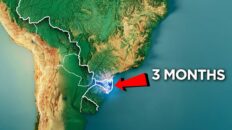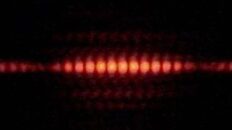We all know space junk is a problem. Well meet the solution. Privateer Space is creating the tools necessary to clean up space debris and avoid collisions in space. If you’d like to see my full interview with co-founder Moriba Jah, check it out here on my Conversations With Joe channel: https://youtu.be/7-vgodcgZzQ
TRANSCRIPT:
Think about the speed of a bullet. It’s so fast we can’t see it. Whenever we visualize it in movies or stock footage like this, we have to slow it down. Way, way down.
The fastest bullets travel at about 2200 feet per second, that’s about 1500 miles per hour. If you fired a round across an American football field, which is 300 feet, it would go from end to end in .136 seconds. At 30 frames per second on video, that would take up about 4 frames. Like this.
Blink and you’ll miss it. What about something bigger though, like say the International Space Station…
It’s easier to see. But that’s still crazy fast. From the perspective of someone on the field, though…
That would definitely get your attention – but you might not even know what it was.
But here’s the thing… the space station is actually traveling much, much faster than that. More than 10 times faster than that. So fast that if it flew across this football field at actual speed…
It would just vaporize in the air. And the whole stadium while it’s at it.
But let’s say you could get above all that air and float in one spot in space. Keeping in mind everything I just talked about, if the International Space Station flew past you at 17,000 miles per hour, it would look like this…
Did you miss it? I think we missed it.
Turns out that it’s impossible to even catch it at 30 frames a second. In other words…
If the ISS flew past you in space, you wouldn’t see it, you wouldn’t hear it, you wouldn’t feel a gust of wind coming off of it, an object the size of a football stadium would pass right in front of you, and you would have no idea it happened.
Orbital speeds are ridiculous, and there are tens of thousands of objects flying around at that speed. Tracking these objects has become vital for the continued functioning of our modern world.
Luckily there’s a company that’s doing just that. And today, we’re going to talk about them.
Space Junk History
Space junk has existed for as long as we’ve been launching satellites. Like I did this compilation of cool space footage recently and this shot was from 1959 and look at that… Space junk!
Actually, if that manhole cover thing is true, I guess that would be the first space junk. Operation Plumbbob. Did a video about it. Hey, did I mention I’ve done other videos?
Operation Plumbbob
Anyway, the North American Aerospace Defense Command, or NORAD, has been tracking orbital debris since 1957. More than 32,000 of the 54,000-plus objects they track are considered debris.
Some of the earliest debris pieces came from SPUTNIK 4. The Russian satellite carried a mannequin and a dog named Chernushka to orbit in 1961.
Don’t worry, they both came home safe. They’re not still floating up there, but bits of SPUTNIK 4 stayed in space for years.
In 1962, a 20-pound chunk fell in front of the Rahr-West Art Museum in Manitowoc, Wisconsin. The museum still celebrates with an event called Sputnikfest.
I could go down a long list of space junk incidents but I’ve already covered that… In another video…
Suffice it to say that hundreds of accidents and intentional explosions have littered Earth’s orbit. And this does cause problems, especially for the ISS crew.
ISS Headaches
For instance, there was the 2007 test of a Chinese anti-missile system that created 3500 pieces of debris. 14 years later in November 2021, the ISS had to make an emergency maneuver to avoid hitting one.
Less than a week later, the ISS crew had to shelter in landing capsules after a Russian missile test resulted in 1500 pieces of debris.
The fragments the ISS dodges are usually smaller than a softball. That sounds like no big deal. But a direct hit could have a combined speed of over 54,000 kilometers per hour (34,000 mph).
Even specks of dust at that speed can do major damage. Past, minor impacts have cracked windows in the ISS and poked holes in its robotic parts.
Other spacecraft, like Hubble, have been cratered by impacts with man-made junk.
Kessler Syndrome
I could go on, but you get the point. And some governments do, too – finally.
A recent change at the FCC limits communication satellites serving the U. S. market to lifespans of 5 years after their mission’s end, down from the previous 25.
That’s a good start. But reliable estimates say that if no new spacecraft are launched, collisions will continue to rise through the year 2200.
And scientists have been warning for years that if enough collisions happen, it will become impossible to safely launch anything to space.
This is the so-called Kessler syndrome, named for Donald Kessler, a NASA scientist and advocate for cleaning up our orbit.
In an extreme case, a domino effect of orbital collisions could destroy every object in orbit and stop them from being replaced. This would be devastating to the economy.
Worse, in my book, would be the chilling effect on human space exploration. We could forget about trips to the Moon or Mars for years, if not decades. The spaceflight programs of today might never recover.
Privateer’s Moriba Jah
But there is a company working to prevent that.
That company is Privateer Space. I’ve talked about Privateer before. And this summer, I got a chance to interview the company’s co-founder and chief scientist, Moriba Jah.
Moriba is an amazing guy who’s made a career as an aerospace engineer and space environmentalist (recently received the MacArthur Genius Grant). How he got into that career is a fascinating story.
The Platform Approach
As you heard, Privateer’s product is a dataset. Privateer is a platform company that wants to enable other companies, agencies, and individuals with space ideas to do their thing. You can see an application of their platform at privateer.com.
At least the time of this video, the Privateer homepage shows Wayfinder, a visualization tool based on Doctor Jah’s work. Under the hood, Wayfinder compiles data from multiple sources to predict the flight of orbital objects.
The platform approach means companies can access the data in different ways.
Orbital Predictions
And, they’re making that data available for free. You may have noticed the buttons next to that sexy, OMEGA watch on the homepage. You can use those to pause, play, or fast-forward the Wayfinder’s visualization.
Privateer allows free predictions of where objects will be up to 24-hours in advance. Clients who want to look further can pay for what CEO Alex Fielding has called “bespoke” information. As in, tailored to fit the client’s needs.
In addition to Wayfinder, Privateer has started a BETA program for a service called Crow’s Nest.
It predicts collisions between orbital objects, putting a number to the chance of an impact . You can access Crow’s Nest through an icon on Wayfinder’s display that looks like the emoji for frowning cyclops.
Future Satellite Sources
In my interview with Moriba, I asked if Privateer has any space launch ambitions. He mentioned that the company would like to have its own sources of data. To that end, they’ve designed a constellation of small satellites.
Two of these, called Pono-1 and Pono-2, were supposed to go to orbit in 2022. Last I looked, the launch of Pono-1 was still TBD. Pono, by the way, “stands for righteousness and balance” according to a tee-shirt shop I found online.
The name is Hawaiian and Privateer is based in Hawaii. I think the name does a good job reflecting the company’s values. We should all be “righteous” in taking stewardship of Spaceship Earth.
Privateer’s Partnerships
To that end, Privateer has announced several partnerships with companies of like mind. One is Astroscale, a Japanese company that wants to provide End-of-Life-Service for satellites.
They sent two test satellites to orbit in 2021. One of these was a servicer satellite. The other was a client, standing in for test debris. The servicer was able to grab the client with a magnet, then release it and navigate autonomously.
Privateer has also partnered with SCOUT, another company in the space data sector.
The details of the partnership are technical, not to say vague, but SCOUT is known for machine vision and cubesat technology. So make of that what you will.
Last year, Privateer announced a partnership with the U. S. Space Force, but I haven’t been able to find updated details.
Cleaning Up Orbit
So we’ve established that they’re building the platform for others to use, here are some companies that might be using it.
I mentioned Astroscale’s magnet already. Since 2019, ESA has making plans to de-orbit debris using multi-armed satellite ClearSpace-1.
Going back even further, there have long been proposals to fit the ISS with a laser cannon, or use a ground-based “laser broom” to sweep debris away.
Sadly, I don’t know of any space laser prototypes being tested at the moment, but the concept is being studied.
Also in the design phase are methods for recycling objects in orbit. A company called WidgetBlender LLC recently won a NASA challenge by adapting concepts they developed for asteroid mining.
So, there are people working on this, and Privateer’s platform is going to make it possible. That’s the idea.
More on Moriba Jah
Which is why this September Moriba was picked to receive funding from NASA for orbital debris mitigation research.
Then, in October, he was named a MacArthur Fellow, and given the MacArthur Genius Grant, and by the way, a big public congratulations for that.
Orbital mechanics is hard. It’s just as hard as rocket science. Because that’s what it is. It’s rocket science.
I mean as I was saying at the beginning, the physics of objects moving at that speed is just insane.
That’s why it’s a good thing we’ve got people like Privateer making sure things in that environment operate as smoothly and cleanly as possible. Can’t have any potholes on this highway.
Anyway, if you want to know more about this topic, I’ve got my full interview with Moriba over on my Conversations With Joe channel. I do have a podcast, it’s a whole other thing. But yeah if you found this interesting at all, we cover all kinds of stuff over there. I’ve got links all over this thing.




Add comment